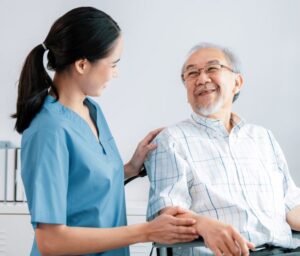 For most children and younger adults, a fracture or broken bone requires wearing a cast and keeping the affected limb immobile. Once the area heals, you begin physical rehabilitation and eventually resume an active lifestyle. For adults over 65, fractures are far more serious.
For most children and younger adults, a fracture or broken bone requires wearing a cast and keeping the affected limb immobile. Once the area heals, you begin physical rehabilitation and eventually resume an active lifestyle. For adults over 65, fractures are far more serious.
These injuries can lead to other health issues that compromise independence, mobility and quality of life. For yourself or an older loved one, understand the concerns surrounding broken bones.
Causes of Fractures In Older Adults
Seniors are more susceptible to fractures due to changes in the body. Starting in your 30s, bone tissue is lost at a faster rate than the body can create it.
In your 60s and beyond, falling down, leaning too far or lifting a heavy object can potentially lead to a bone fracture. Factors like osteoporosis, age-related hormonal changes and loss of testosterone further increase these risks.
An estimated 50 percent of women and 25 percent of men over age 50 experience a fracture related to osteoporosis. Additional factors that can increase an older adult’s risk include:
- A previous fracture or broken bone
- Arthritis
- Cancer
- Kidney failure
- Absorption and other intestinal issues
- A sedentary lifestyle
- A family history of hip fractures
- Insufficient vitamin D levels
- Long-term alcohol and tobacco use
- Long-term medication use
- Changes in physical gait
- Vision changes
- Neuropathy
- Living conditions, including clutter or obstructions that can pose trip hazards
Why Fractures Are Concerning for Seniors
Physical changes can make older adults more vulnerable to fractures. You’re more likely to experience a fracture over 65 due to balance issues, slower reflexes, a lack of coordination and poor depth perception.
High-impact fractures can result in more traumatic injuries that come with a higher mortality rate. While low-impact or fragility fractures may not appear serious, they come with an equally high mortality rate due to how the body attempts to heal with age.
As such, research has shown the mortality rate for fractures among older adults is on par with cancer. Unfortunately, these rates do not decline once the injury heals. Instead, mortality rate remains elevated for roughly a decade following a fracture.
How the Body Heals
When an older adult experiences a fracture, decreased muscle strength and a weaker immune system impact the healing process. In fact, about 15 percent of these fractures do not heal at all. Diminished blood supply means that oxygen, essential for tissue repair, is not sufficiently delivered to the area.
For the healing process, you’ll be given a cast, a few rods or pins to keep the bone together, and told to avoid putting weight directly on the affected area. However, rather than rest all the time, it’s recommended to remain active through physical therapy and your daily life.
Remaining sedentary can cause your muscle mass and strength to decline further and elevates risk for ulcers, blood clots and pneumonia. Inadequate recovery can result in:
- Decreased quality of life, permanently affecting independence and mobility.
- Increased risk for chronic pain and future fall injuries.
- The need for at-home care. About 25 percent of older adults who break a bone after age 65 will experience a second injury within the next five years.
To better support your fracture recovery:
- Make sure you have a plan for meal prep, getting around, showering and dressing.
- Have your living space updated to reduce fall risks and improve mobility. Secure rugs, clear pathways for walking, add sufficient lighting, eliminate trip hazards, get steps repaired and have grab bars installed in your home.
- Focus on your bone health. Get enough calcium and vitamin D, stop tobacco use, limit caffeine and alcohol intake, and continue to be physically active.
If you’re recovering from an injury or concerned about fracture risks, Avon Health Center can help guide your care. To learn more about short-term rehabilitation, contact us today.

